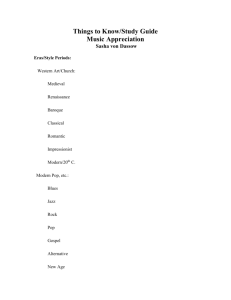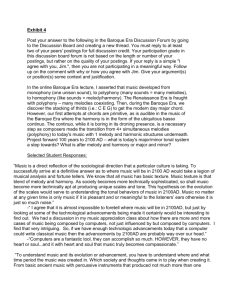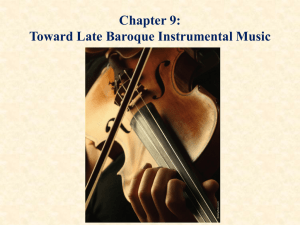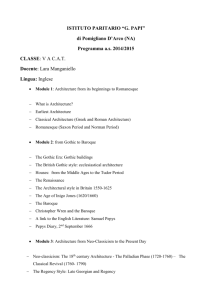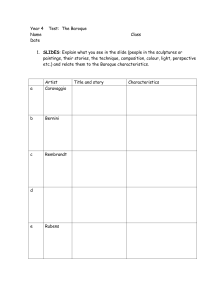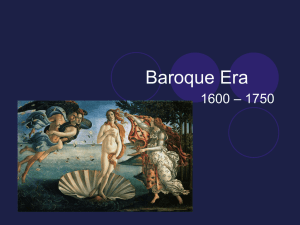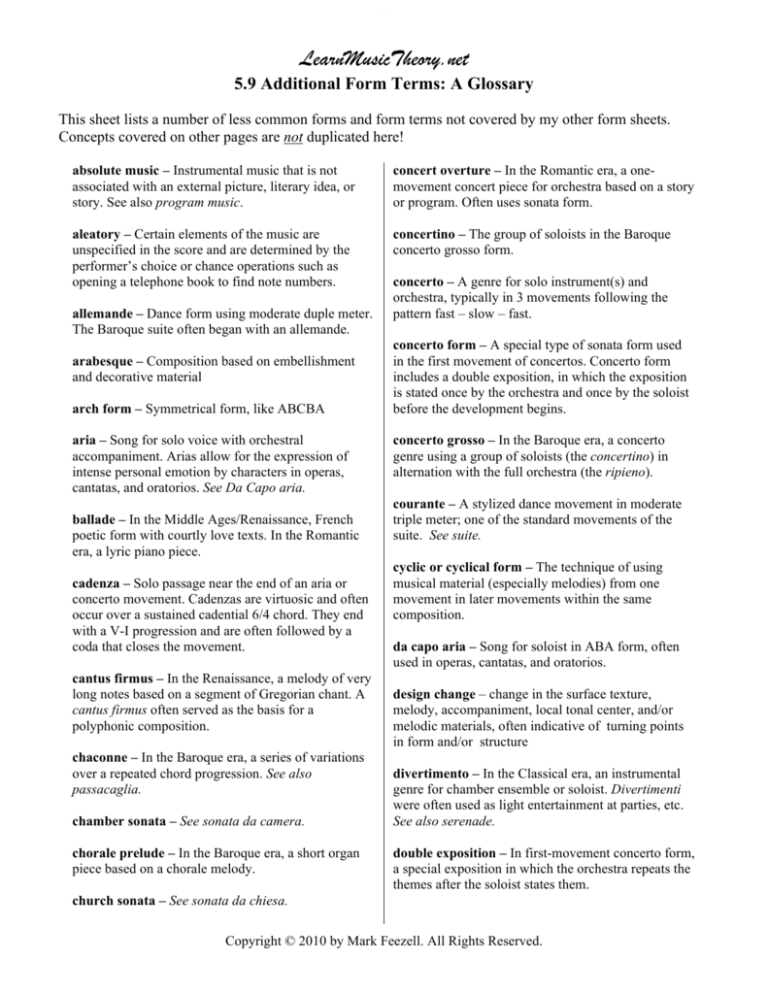
.
LearnMusicTheory.net
5.9 Additional Form Terms: A Glossary
This sheet lists a number of less common forms and form terms not covered by my other form sheets.
Concepts covered on other pages are not duplicated here!
absolute music – Instrumental music that is not
associated with an external picture, literary idea, or
story. See also program music.
concert overture – In the Romantic era, a onemovement concert piece for orchestra based on a story
or program. Often uses sonata form.
aleatory – Certain elements of the music are
unspecified in the score and are determined by the
performer’s choice or chance operations such as
opening a telephone book to find note numbers.
concertino – The group of soloists in the Baroque
concerto grosso form.
allemande – Dance form using moderate duple meter.
The Baroque suite often began with an allemande.
arabesque – Composition based on embellishment
and decorative material
arch form – Symmetrical form, like ABCBA
aria – Song for solo voice with orchestral
accompaniment. Arias allow for the expression of
intense personal emotion by characters in operas,
cantatas, and oratorios. See Da Capo aria.
ballade – In the Middle Ages/Renaissance, French
poetic form with courtly love texts. In the Romantic
era, a lyric piano piece.
cadenza – Solo passage near the end of an aria or
concerto movement. Cadenzas are virtuosic and often
occur over a sustained cadential 6/4 chord. They end
with a V-I progression and are often followed by a
coda that closes the movement.
cantus firmus – In the Renaissance, a melody of very
long notes based on a segment of Gregorian chant. A
cantus firmus often served as the basis for a
polyphonic composition.
chaconne – In the Baroque era, a series of variations
over a repeated chord progression. See also
passacaglia.
chamber sonata – See sonata da camera.
chorale prelude – In the Baroque era, a short organ
piece based on a chorale melody.
concerto – A genre for solo instrument(s) and
orchestra, typically in 3 movements following the
pattern fast – slow – fast.
concerto form – A special type of sonata form used
in the first movement of concertos. Concerto form
includes a double exposition, in which the exposition
is stated once by the orchestra and once by the soloist
before the development begins.
concerto grosso – In the Baroque era, a concerto
genre using a group of soloists (the concertino) in
alternation with the full orchestra (the ripieno).
courante – A stylized dance movement in moderate
triple meter; one of the standard movements of the
suite. See suite.
cyclic or cyclical form – The technique of using
musical material (especially melodies) from one
movement in later movements within the same
composition.
da capo aria – Song for soloist in ABA form, often
used in operas, cantatas, and oratorios.
design change – change in the surface texture,
melody, accompaniment, local tonal center, and/or
melodic materials, often indicative of turning points
in form and/or structure
divertimento – In the Classical era, an instrumental
genre for chamber ensemble or soloist. Divertimenti
were often used as light entertainment at parties, etc.
See also serenade.
double exposition – In first-movement concerto form,
a special exposition in which the orchestra repeats the
themes after the soloist states them.
church sonata – See sonata da chiesa.
Copyright © 2010 by Mark Feezell. All Rights Reserved.
5.9 Additional Form Terms: A Glossary, cont.
doubles – The name for each variation in a French
keyboard suite. See ordres.
elision – An overlap in which the cadence chord
terminating one phrase becomes the first chord of the
next phrase.
étude – Study that focuses on a technical problem for
a particular instrument.
fantasia – Extended instrumental piece (often
Baroque) intended to sound like an improvisation.
fixed forms – A set of forms from medieval France
based on fixed poetic structures. The fixed forms
include the ballade, the rondeau, and the virelai.
French overture – In the Baroque era, an
introductory movement for an opera, ballet, or suite,
having a slow introduction followed by an allegro.
gavotte – In the Baroque era, stylized dance type in
duple meter having a pastoral character.
gigue – An English Baroque dance in fast compound
meter. The gigue was a standard movement in the
Baroque suite.
ground bass – A melody that repeats in the bass
throughout an entire movement. See passacaglia.
idée fixe – “ee-DAY feeks” A term coined by Berlioz
and especially relevant to his Symphonie fantastique.
An idée fixe returns in various movements and unifies
a work. See cyclic form.
incidental music – Music intended to be performed
with a play.
interlude – Music composed to stand between
primary sections of a composition, opera, or play.
intermezzo – In the 18th-century, a comic interlude
between the acts of an opera seria. In the Romantic
era, a short, lyrical composition, usually for piano.
isorhythmic motet – In the Medieval and early
Renaissance eras, a motet using isorhythm. Isorhythm
is the technique of repeating a pitch sequence and
rhythm sequence of different lengths throughout the
piece. The rhythm sequence is called the talea, and the
pitch sequence is called the color.
Italian overture – In the Baroque era, an overture
with the sectional pattern fast – slow – fast.
Leitmotif – The basic recurring melody associated
with a person, object, or idea throughout a Wagnerian
opera.
Lied – In the 19th century, a solo art song with piano.
(Lied is German for “song.”)
madrigal – In the Renaissance, a secular vocal
composition with or without accompaniment and
using a short love text. Madrigals were most popular
in Italy and England.
march – A movement or piece with accented duple
meter, repetitive rhythms, and a generally military
character.
mazurka – Folk dance of Poland in triple meter.
Chopin wrote a number of mazurkas for piano.
minimalist music – Contemporary style using
extensive repetition of simple melodic or rhythmic
patterns.
moment form – Form in which each instant of the
composition stands on its own without any formal
connection to the other sections of the piece.
monothematic – Composition or movement using
one theme.
nocturne – A piece designed to evoke the peaceful
tranquility of night. Chopin wrote many for piano.
open form – Contemporary approach to form in
which the performer or chance operations (such as
looking up numbers in a phone book) determine the
order of the sections in the form.
oratorio – In the Baroque era, a dramatic composition
for solo voices, chorus, and orchestra, intended to be
performed in a concert setting (without scenery and
costumes). Oratorios typically used religious or other
serious texts.
ordre – See suite. Couperin coined this term and it
was later used for some French suites.
ostinato – A short repeated musical pattern. Ostinati
may be melodic, rhythmic, or harmonic.
Copyright © 2010 by Mark Feezell. All Rights Reserved.
5.9 Additional Form Terms: A Glossary, cont.
partita – See suite.
passacaglia – In the Baroque era, a piece in slow
triple meter with a ground bass.
phasing – Contemporary technique in which
performers gradually move “out of phase” then back
“in sync” as they perform an ostinato together in
unision and one performer speeds up slightly.
program music – Instrumental music that has
associations with images, literary concepts, or a story.
See also absolute music.
recitative – Solo vocal movement that attempts to
recreate the rhythms and inflections of ordinary
speech; in operas, canatatas, and oratorios.
ripieno – In a Baroque concerto grosso, the large
ensemble that alternates with the concertino.
ritornello – In a Baroque concerto, the tutti passage
that recurs between solo sections.
sarabande – In the Baroque era, a Spanish stylized
dance type in triple meter. The sarabande was one of
the four standard movements of the German suite.
See suite.
serenade – In the Classical era, an instrumental genre
performed at evening social functions. Closely related
to the divertimento and cassation.
Perhaps the most famous is Mozart’s Eine Kleine
Nachtmusik.
suite – A multimovement grouping of contrasting
dance movements, generally sharing a single key.
Also called partita and ordre. Many Baroque suites
consist of an Allemende, Courante, Sarabande, and
Gigue. This combination was commonly called a
“German suite” form. French suites were less
predictable.
symphonic poem – In the Romantic era, a singlemovement composition for orchestra with a program
(see program music). Also tone poem. Franz Liszt
(1850’s) and Richard Strauss (early twentieth century)
are important composers of tone poems.
symphony – Orchestral work in 3 or 4 movements.
Typically, the first movement is in sonata form, the
second is a slow movement, the third is a minuet and
trio or scherzo and trio, and the fourth is a rondo or
sonata form. Many variations of this basic template
exist.
trio sonata – In the Baroque era, a chamber sonata
with two melody lines and a basso continuo bass line.
The basso continuo bass line would have been
realized by a bass instrument (such as cello) and a
keyboard player, yielding a total of 4 performers.
variation – The repetition of musical materials with
alteration, but such that the source materials are still
recognizable.
vocalise – A vocal melody without text.
waltz – Triple meter dance type. In the Romantic era,
a stylized dance type often used for piano pieces.
sonata da camera – In the Baroque era, an
instrumental suite of stylized dances. Also called
chamber sonata.
sonata da chiesa – In the Baroque era, an
instrumental work for church performance. Usually
had 4 movements: slow—fast—slow—fast. Also
called church sonata.
song cycle – Grouping of songs that share musical
elements or textual relationships and are often
intended to function as a single composition.
strophic form – Vocal form in which the same music
is repeated with different stanzas (or strophes) of text.
Copyright © 2010 by Mark Feezell. All Rights Reserved.



